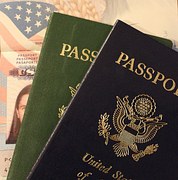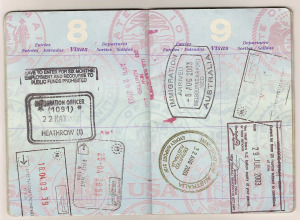By Rolf Garcia-Gallont
At What Point During the Immigration Process Must a K-2 Visa Holder Be Under 21 Years Old to Be Eligible for Conditional Permanent Residence as a “Minor Child”?
In Regis v. Holder, the Fourth Circuit denied a petition to review an order of the Board of Immigration Appeals (“BIA”). The Petitioner, Noel Regis, was a citizen of the Philippines who had entered the United States on a K-2 visa he had received as the minor child of his mother, a nonimmigrant fiancée K-1 visa holder. After his mother married the U.S. citizen who had petitioned for the family’s K visas, Regis applied to adjust his status to lawful conditional permanent resident.
The United States Citizenship and Immigration Services (“USCIS”) denied Regis’ application because he had turned 21 before he entered the United States and was therefore not a qualifying “minor child” under the Immigration and Nationality Act (“INA”). An immigration judge agreed with USCIS, and the BIA affirmed.
In his petition for review, Regis contended that a K-2 visa holder’s eligibility for adjustment of status should be determined not by his age on the date of entry into the United States, but rather by his age at the time he initially sought the K-2 visa.
The K-1 / K-2 “Fiancé(e) Visa” Process
A K-1 visa allows the foreign-citizen fiancé(e) of a U.S. citizen to travel to the United States and marry his or her U.S. Citizen sponsor within 90 days of arrival. After the marriage, the foreign citizen applies for adjustment of status to that of “lawful conditional permanent resident.” If the foreign citizen has a minor child that is accompanying or following to join the parent, that child may receive a K-2 visa and apply for adjustment of status after the parent’s marriage.
Section 1255 of the INA, which addresses adjustment of status for K-1 and K-2 nonimmigrant visa holders, does not specify at what point during the immigration process a “minor child” is required to be under 21 years of age to be eligible for adjustment of status.
Regis’ K-2 visa was issued on February 13, 2007, five days before his 21st birthday. Regis’ mother married her U.S. citizen fiancé in the United States on February 26, 2007. Regis did not accompany his mother, but entered the United States on March 25, 2007, over a month after his 21st birthday. In May 2007, Regis filed an application for adjustment of status. USCIS denied the application, and began removal proceedings in November 2007.
A K-2 Visa Holder Must Be Under 21 Years Old at the Time He Actually Enters the United States to Be Eligible for Adjustment of Status as a “Minor Child.”
Throughout his appeal process, Regis relied on Carpio v. Holder, a 2010 Tenth Circuit case, in support of his argument that the proper date to determine his “minor child” eligibility was the date when he applied for the K-2 visa.
In Carpio, the K-2 petitioner had entered the United States when he was less than 21 years old, but the BIA denied adjustment of status because the petitioner had turned 21 before the agency adjudicated his application. The Tenth Circuit overturned the Board’s decision, concluding that eligibility should be determined as of the date a K-2 alien “seeks to enter” the United States. The Carpio court did not need to pinpoint when a K-2 applicant “seeks to enter,” but observed that the date may be plausibly read as either (a) the date that the United States citizen files a petition for K-1 and K–2 visas, or (b) the date that the K–1 and K–2 visa applications are filed with the consular officer in the country of origin.
The immigration judge in Regis’ case found Carpio inapplicable under the holding in Matter of Le, which the BIA itself had decided in 2011 while the Regis case was pending. In Matter of Le, a three-judge panel of the Board concluded that a K-2 visa holder’s age at the time he actually enters the United States determines whether he is a “minor child” under the INA.
The BIA’s Interpretation of When “Minor Child” Status Must Be Established Is Entitled To Deference Under The Chevron Doctrine
The question before the Fourth Circuit was whether the BIA’s interpretation of the INA in Matter of Le was precedential and dispositive. The court recognized that because the BIA is the agency that administers the INA, its interpretations of that Act may be entitled to deference under the Chevron doctrine if (1) the statute is silent or ambiguous with respect to the specific issue; and (2) the agency’s interpretation is not arbitrary, capricious, or manifestly contrary to the statute. The first prong of the Chevron test was not at issue, so the court moved on to consider whether the BIA’s interpretation in Matter of Le met the second prong.
In Matter of Le, the BIA had reasoned that visa eligibility is best determined on the date of an alien’s entry into the United States, because eligibility is reassessed at the port of entry, and events may occur between visa issuance and admission that could extinguish the visa.
As to K-2 visa holders in particular, the Board further observed that the gap between issuance of the visa and admission “provides an additional opportunity for the parent’s visa validity to be extinguished, which would, in turn, render the child inadmissible even though a K-2 visa had been issued.” For example, if Regis’ mother had not married her U.S.-citizen fiancé within 90 days of arriving in the United States, Regis’ K-2 visa would have become invalid, and he would not have been able to follow his mother into the United States at a later date even though he had been issued a K-2 visa. The Fourth Circuit agreed with the BIA’s reasoning, and held that it was entitled to deference under Chevron.
Because Regis Was Over 21 When He Entered the United States, His Application for Adjustment of Status Was Properly Denied
The Fourth Circuit held that the BIA’s interpretation of the INA –- that a K-2 visa holder seeking adjustment of status must be under 21 at the time of admission – was a permissible construction and was owed deference under the Chevron doctrine. Accordingly, because Regis was over 21 when he entered the United States, the court held that his application for adjustment of status was properly denied, and in turn denied Regis’ petition for review.












